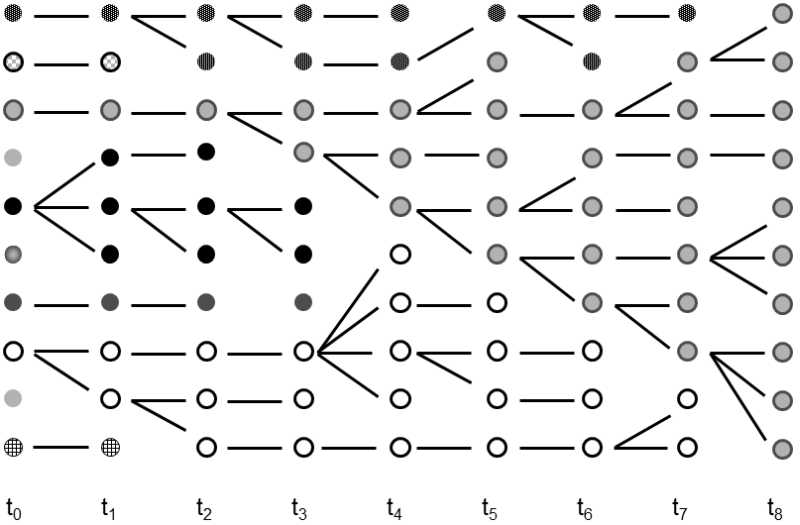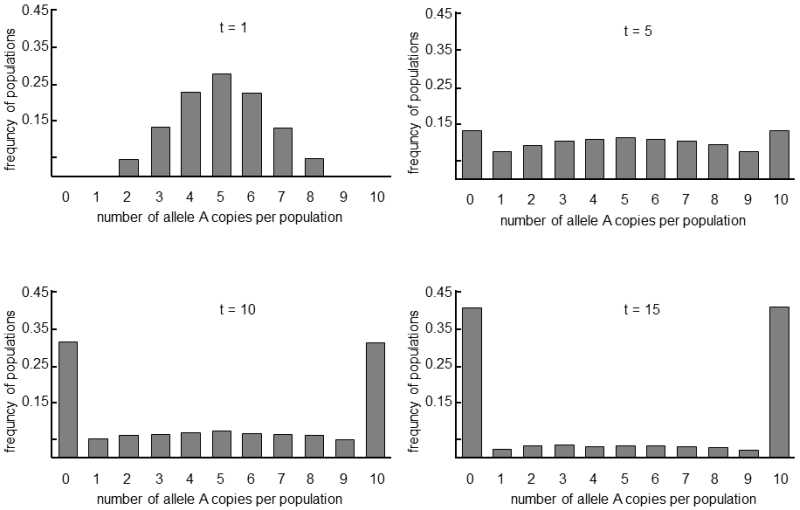V.2 In populations of finite size, genetic drift leads to fixation of some alleles.
There is the same probability that, through genetic drift, the frequency of certain alleles will increase or decrease from one generation to the next.In an infinitely large population, genetic drift would thus lead to regular reversible fluctuations in the frequency of the individual alleles.From the standpoint of evolutionary processes, these random fluctuations should be of relatively small importance.
However, the situation is different in real populations.The sizes of the populations of fauna and flora are always finite and are frequently greatly limited.Species living permanently in relatively isolated populations (domains) containing only several dozen individuals are not exceptional amongst mammals.Genetic driftmust necessarily lead to fixation of alleles in small populations.It is irrelevant how many various alleles were present in the population in the beginning.Following a sufficiently large number of generations, the bearers of only one of them will remain in the population (Fig. V.2).

Fig. V.2. Elimination of the original alleles in the population through the action of genetic drift. Of the original spectrum of alleles in the population at time t0, the individual alleles gradually disappear through the action of genetic drift so that, finally, all the members of the population bear a copy of only a single original allele. Of course, in real systems, the individual copies of the original allele gradually accumulate mutations and, as a consequence, mutually diverge. Thus, the total amount of polymorphism present in the population need not decrease.
Fixation of alleles occurs when their frequency reaches 100 %, i.e. when the frequencies of the other alleles of the relevant gene decrease to zero for some reason.There can be various reasons for a similar decrease in frequency, such as natural selection acting against the bearers of certain alleles.However, it is most probable that the process leading to fixation of the greatest number of mutations will be genetic drift or a process whose biological consequences are very similar (i.e. fixation of neutral mutations) – genetic draft (see IX.5.2).
The mechanism of fixation of alleles through the action of genetic drift in individual populations can best be demonstrated on the example of a large number of small populations in which alleles A and a are present in the same frequencies at the beginning of the experiment (Fig. V.3).

Fig. V.3. Fixation of alleles in small populations through the action of genetic drift. The histograms depict the developments in the distribution of populations with various frequencies of certain alleles. At time t = 0, all the populations were formed of five heterozygotes with one allele A and a second allele a. The fraction of the population with a certain frequency of allele A is plotted on the vertical axis. As the number of generations increases, the histogram gradually becomes flatter, there is a reduction in the number of populations with the original balanced frequency of both alleles and there is also an increase in the frequency of the populations in which fixation of one or the other allele occurred.
The set of these populations at the individual moments in time can always be depicted by the relevant histogram, expressing the frequency of populations with frequency of allele A lying in the intervals 0-0.1; 0.1–0.2; 0.2–0.3; ... 0.9–1At time t0 all the populations lie within a single frequency interval as the initial frequency of alleles A in all the populations equals 0.5.Following a certain number of generations, populations begin to occur increasingly often in which the frequency of allele A deviates ever more from value 0.5.The histogram begins to approach the histogram of normal distribution, where the standard deviation of the set increases constantly with time and the histogram thus becomes flatter.An important difference in the shape of the histogram or the normal distribution begins to appear when some populations begin to reach extreme positions through the effect of genetic drift, i.e. when populations with frequency of allele A equal to 1.0 to 0.0 appear in the population.If the individual populations are mutually isolated and if alleles A and a can change one into the other through the effect of mutation within the time horizon of our experiment, these states are irreversible for the given population and one or the other allele becomes fixed.As time progresses, additional populations will be in this state so that, after a sufficiently long time, only the two extreme columns will be present in the histogram.Approximately half the population will have a frequency of allele A equal to 1.0 and the other half will have frequency equal to 0.0.
